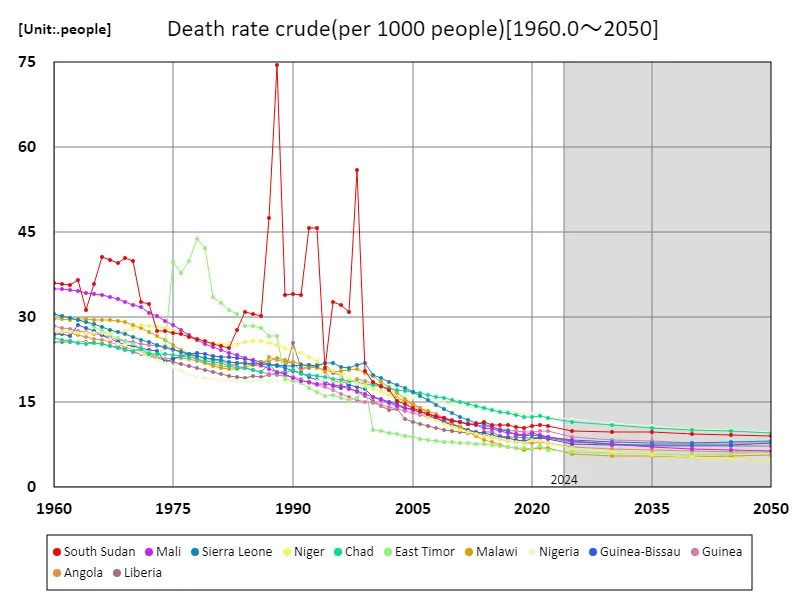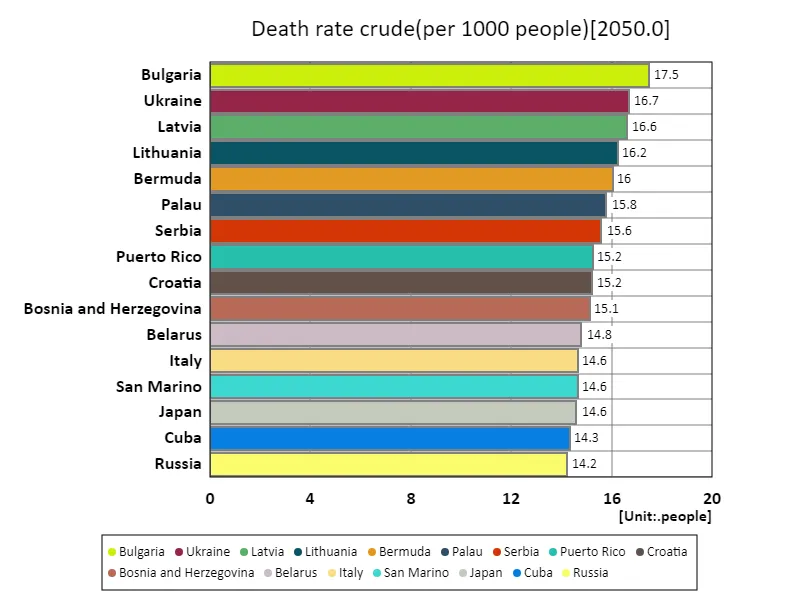Abstract
Several factors are behind Nigeria’s projected crude death rate of 9.83 in 2050. First, Nigeria has a rapidly growing population with a high proportion of young people, which means that the crude death rate tends to be relatively high. Looking back at historical data, Nigeria has maintained high birth and associated mortality rates for many years, but has seen more recent improvements in healthcare and public health. Yet economic challenges, poverty and a lack of infrastructure continue to hinder progress in reducing mortality rates. Furthermore, in countries with high crude death rates, where child mortality is particularly high, future policies will need to focus on strengthening education and health care.
Crude death rate (per 1,000 people)
South Sudan’s crude death rate was extremely high at 74.6 in 1988, due mainly to the country’s prolonged civil war and social unrest. During this period, war, famine and lack of medical care led to high mortality rates. However, South Sudan has shown some improvement in subsequent decades. For example, the current crude death rate is around 12.1% of the peak, thanks to improvements in medical services and public health, as well as international assistance. Overall, across the data from 1960 to 2050, war, disease and poverty were prominent causes of high mortality in developing countries, but in recent years many countries have shown signs of improvement, with improved access to healthcare playing a major role.


The maximum is 74.6people[1988] of South Sudan, and the current value is about 12.1%
Crude death rate (per 1000 people) (Worldwide)
The high crude death rate in South Sudan in 1988 was 74.6 people, a result of a long civil war, political turmoil, poverty, and a lack of medical care. The improvement from this peak to the present is due to international assistance, humanitarian intervention and improved health services. In particular, the spread of education and measures to combat infectious diseases were effective and contributed to a decline in the mortality rate. Overall, between 1960 and 2050, war and epidemics will be the main drivers of crude death rates in developing countries, while economic growth and social stability will lead to declining mortality rates. South Sudan’s improvements offer hope for other low-income countries, but more work needs to be done to achieve sustainable development.


The maximum is 74.6people[1988] of South Sudan, and the current value is about 12.1%
Crude death rate (per 1000 people) (worldwide, latest year)
According to the data for 2050, Bulgaria records the highest crude death rate at 17.5. This is because Bulgaria is facing an ageing society. As the population ages, natural mortality rates tend to increase. Compared to the overall average of 9.68, Bulgaria’s high value reflects changes in the population structure. The total figure of 1,810 also suggests regional differences, particularly due to ageing populations and the development of medical services. Over the past few decades, the trend has been for developed countries to experience higher crude death rates as their populations age, while developing countries have seen their mortality rates fall as a result of improvements in public health and medical care. Overall, we find that social and economic changes have a significant impact on crude death rates.


The maximum is 17.5people of Bulgaria, the average is 9.69people, and the total is 1.8kpeople
Crude death rate (per 1000 people) (region, latest year)
According to the 2050 data, the region with the highest crude death rate is Central Europe and the Baltic States, with 14 deaths. This is closely linked to the ongoing ageing of these regions. In particular, in developed countries, population aging is progressing along with declining birth rates, and the increase in the elderly population is causing an increase in crude death rates. On the other hand, the overall average crude death rate is 9.71, which is also affected by the aging society. However, in some regions, it has been kept relatively low due to advances in medical technology and improving standards of living. The total figure of 146 represents the total number of deaths in areas where aging is particularly prevalent, and signifies the heavy social and economic burden that comes with aging. Historically, ageing populations in developed countries and improvements in medical care in developing countries have had a major impact on crude death rates, highlighting regional differences.


The maximum is 14people of Central Europe and the Baltics, the average is 9.71people, and the total is 146people



Comments